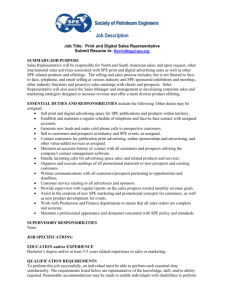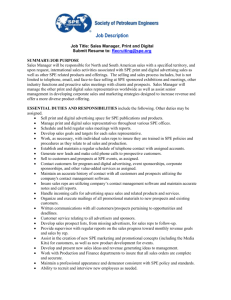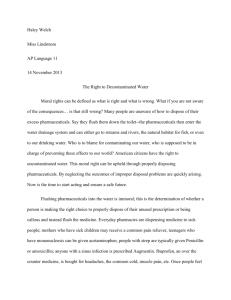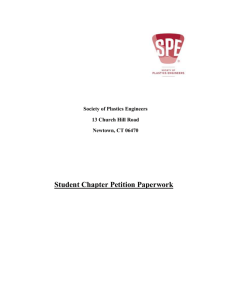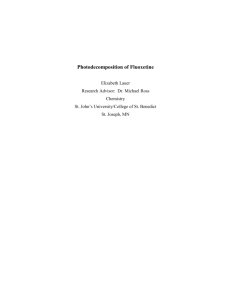Analysis of Anti-Depressants in St. John`s University Waste and
advertisement
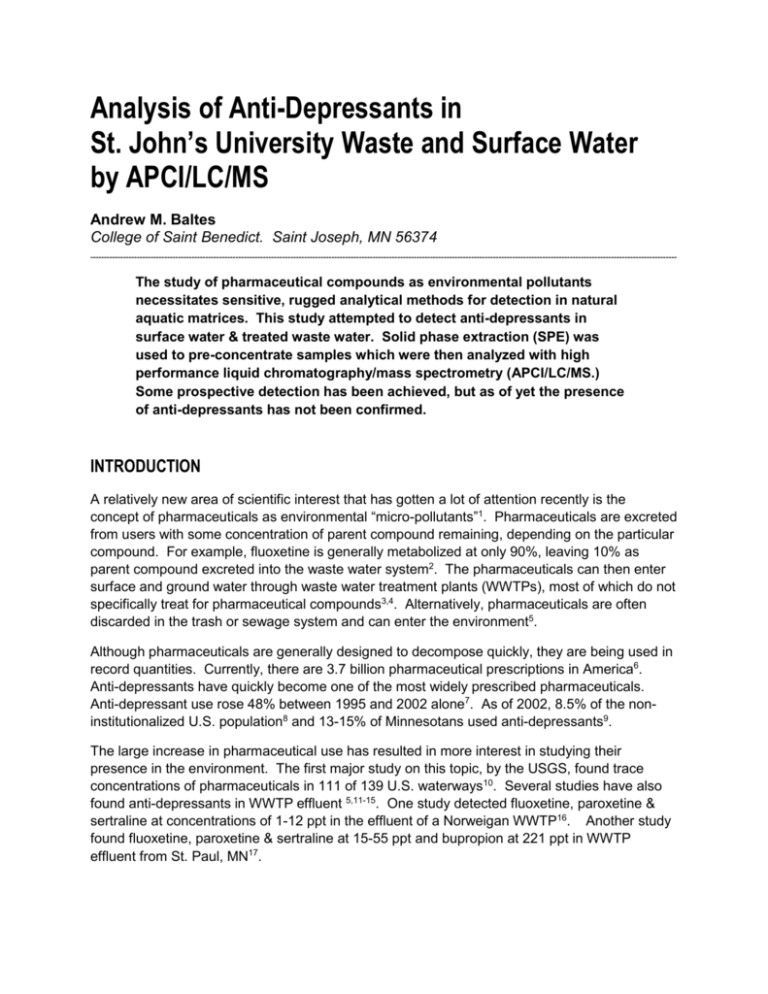
Analysis of Anti-Depressants in St. John’s University Waste and Surface Water by APCI/LC/MS Andrew M. Baltes College of Saint Benedict. Saint Joseph, MN 56374 ---------------------------------------------------------------------------------------------------------------------------------------------------------------------------------------------------------------------- The study of pharmaceutical compounds as environmental pollutants necessitates sensitive, rugged analytical methods for detection in natural aquatic matrices. This study attempted to detect anti-depressants in surface water & treated waste water. Solid phase extraction (SPE) was used to pre-concentrate samples which were then analyzed with high performance liquid chromatography/mass spectrometry (APCI/LC/MS.) Some prospective detection has been achieved, but as of yet the presence of anti-depressants has not been confirmed. INTRODUCTION A relatively new area of scientific interest that has gotten a lot of attention recently is the concept of pharmaceuticals as environmental “micro-pollutants”1. Pharmaceuticals are excreted from users with some concentration of parent compound remaining, depending on the particular compound. For example, fluoxetine is generally metabolized at only 90%, leaving 10% as parent compound excreted into the waste water system2. The pharmaceuticals can then enter surface and ground water through waste water treatment plants (WWTPs), most of which do not specifically treat for pharmaceutical compounds3,4. Alternatively, pharmaceuticals are often discarded in the trash or sewage system and can enter the environment5. Although pharmaceuticals are generally designed to decompose quickly, they are being used in record quantities. Currently, there are 3.7 billion pharmaceutical prescriptions in America6. Anti-depressants have quickly become one of the most widely prescribed pharmaceuticals. Anti-depressant use rose 48% between 1995 and 2002 alone7. As of 2002, 8.5% of the noninstitutionalized U.S. population8 and 13-15% of Minnesotans used anti-depressants9. The large increase in pharmaceutical use has resulted in more interest in studying their presence in the environment. The first major study on this topic, by the USGS, found trace concentrations of pharmaceuticals in 111 of 139 U.S. waterways10. Several studies have also found anti-depressants in WWTP effluent 5,11-15. One study detected fluoxetine, paroxetine & sertraline at concentrations of 1-12 ppt in the effluent of a Norweigan WWTP16. Another study found fluoxetine, paroxetine & sertraline at 15-55 ppt and bupropion at 221 ppt in WWTP effluent from St. Paul, MN17. Although determined concentrations of anti-depressants are relatively low, especially considering the fact that they will be further diluted in surface water, there is still apprehension about the possible environmental effects. The main concerns are the facts that pharmaceuticals are specifically designed to be biologically active, pharmaceutical effects may be additive, and pharmaceuticals are constantly being deposited into the environment at nearly every location humans inhabit1. In addition, some metabolites of pharmaceuticals can still have biological effects and some research shows that pharmaceuticals can degrade more slowly in the environment than was believed when the compounds were approved18. The study of the environmental effects of pharmaceuticals, and anti-depressants in particular, is just beginning. Some studies have shown that anti-depressants are appearing in aquatic organisms at trace levels. One study found that bluegill, black crappie, and channel catfish residing downstream of a Texas waste water treatment plant all contained trace concentrations of fluoxetine and sertraline in their tissues19. Laboratory studies have shown some of the specific effects anti-depressants can have on wildlife. It has been determined that fluoxetine can have an environmental LD50 concentration as low as 234 ppb for some small aquatic organisms19. Reproduction can be significantly affected in C. Dubia (water fleas) by 45 ppb sertraline20 and in zebra mussels by 0.3 ppb fluvoxamine21. Sertraline has been found to be toxic to algae at concentrations of 12.1 ppb22. In order for any kind of meaningful risk assessment, and risk management if it is needed, further research must be carried out. An important component of risk assessment is elucidating the actual concentrations of pharmaceutical compounds in environmental aquatic matrices. For anti-depressant determination to become routine, an efficient, rugged, and sensitive analytical method must be developed; the work outlined in this paper set out to do so. Specifically, work was done to detect a set anti-depressants and metabolites, as well as caffeine and metabolites, (shown in Figure 1) in the waste and surface water of St. John’s University, Collegeville, MN. Solid phase extraction was carried out to pre-concentrate the analytes, which were then analyzed by APCI/LC/MS. METHODS Chemicals Standards of bupropion HCl (>98% purity) and sertraline HCl (>98% purity) were obtained from Toronto Research Chemicals (North York, ON, Canada.) Fluoxetine HCl (>98% purity) was obtained from Spectrum (Gerdena, CA, USA.) Paroxetine HCl hemihydrate (87.1% purity) was obtained from GlaxoSmithKline (Pittsburgh, PA, USA.) Sampling Samples from St. John’s University WWTP were collected from effluent before and after UV light treatment, the last step in the purification process. Samples from East Gemini Lake (EGL) were collected from a runoff outlet. All samples were collected in 5 gallon plastic containers and cooled as quickly as possible to 2-5°C. Eighteen samples were collected between July 10, 2007 and February 1, 2008. Cl Cl O HCl CF3 Cl S NHBu-t N H O S HCl HCl Fluoxetine Bupropion NH Sertraline O Cl Cl CF3 NHBu-t OH H2 N O Cl Hydroxybupropion Norfluoxetine S S NH2 Norsertraline F O N N R NH O S O O O N N N N 1/ Caffeine O HCl O O 2 H 2O H N N Paroxetine O N NH O N N N H 1,7-dimethyl-xanthine N N O Theophylline N Theobromine Figure 1. Chemical structures of anti-depressant, caffeine, and metabolite analytes. Solid Phase Extraction (SPE) All sample aliquots were measured to 6 L. EGL aliquots were then filtered with Whatman filter paper and with a Whatman Polycap 75 AS 0.45 µm filter capsule (Florham Park, NJ, USA) in order to remove any biological particles. Pre- and post-UV treatment aliquots were unfiltered. For those aliquots in which ionic strength was altered, NaCl was added to a concentration of 0.25M. For those aliquots in which pH was altered, formic acid was added to bring pH to about 3 or acetic acid was added to bring to about pH 5. Two to four Supelco ENVI-8 DSK 47 mm diameter 500 µL SPE disks (Bellefonte, PA, USA) were conditioned by wetting the sorbent three times each with methanol followed by water, being careful not to let the sorbent dry. The sample aliquot was then added to the sample reservoirs, vacuum was brought to approximately 50-70 kPa, and SPE carried out at an average flow rate of 15-20 mL/min. All SPE was carried out in complete or partial darkness due to the photosensitivity of analytes. After sample was entirely drawn through, disks were allowed to dry. Retained compounds were eluted from the sorbent with 10x 2 mL acetonitrile or methanol. The extract was then dried under a gentle stream of nitrogen to approximately 1-2 mL. Finally, the sample was reconstituted to 5 mL in acetonitrile or methanol and filtered with a Supelco N-25-2 Nylon IsoDisc 25 mm x 0.2 µm syringe filter (Bellefonte, PA, USA) for HPLC analysis. Liquid Chromatography / Mass Spectrometry Analysis was carried out with a ThermoFinnigan LCQ Advantage Mass Spectrometer and Surveyor (San Jose, CA, USA.) Separation was achieved with an Ascentis Express C18 10cm x 2.1mm, 27 µm column by Supleco (Bellefonte, PA, USA.) Flow rate was kept at 0.1 mL/min and 10 µL of sample were injected. A gradient using methanol and water was used. Methanol was kept isocratically at 25% for 5 minutes and then brought up to 100% at 15 minutes. Photodiode array detection (PDA) was used on the chromatograph. The HPLC was coupled to a quadrupole ion trap mass spectrometer with an atmospheric pressure chemical ionization (APCI) ion source set to positive ion mode. The vaporizer was set to 450°C and the capillary to 200°C. The discharge current was 5 uA and the capillary voltage was 10 V. In addition, some separations were performed without MS detection on a Luna 5u C18(2) 50 x 3.00mm column by Phenomenex (Torrance, CA, USA.) Due to relatively unsatisfactory separation, however, data obtained from this method was not ordinarily used. Method Detection Limits Standard solutions of fluoxetine, paroxetine, and bupropion were made and subjected to SPE followed by analysis. A solution with each at a concentration of 5 ppm was made by adding the appropriate mass of pure solid to 6 L of e-pure water, refrigerating overnight, and then following the SPE extraction procedure as above. A solution with each anti-depressant at a concentration of 5 ppb was analogously prepared with serial dilutions. RESULTS AND DISCUSSION Analysis of Standards Initial analysis was carried out on a standard solution of caffeine, bupropion, fluoxetine and paroxetine in order to determine HPLC retention times and mass spectral information. Results are shown in Table 1. Note that retention times are approximate. Table 1. HPLC Retention Time and Mass Spectral Base Peak of Analytes Analyte HPLC Retention Time (min) Mass Spectral Base Peak (m/z) Caffeine 5.4 267.7 Bupropion 12.3 240.0 Paroxetine 13.0-15.0 330.2 Fluoxetine 13.0-15.0 310.0 Analysis of a 5 ppm standard solution yielded the chromatogram shown in Figure 2. Baseline drift seems to be due to the HPLC gradient used. Mass spectral data obtained from this analysis corresponded to that of the previously analyzed standard solution (Table 1.) Figure 2. Standard solution, 5 ppm concentrations Analysis of a 5 ppb standard solution yielded the chromatogram shown in Figure 3. Corresponding mass spectral data is missing due to instrumental malfunction. However, mass spectra from the 5 ppb standard solution sample analyzed later than 6 days after preparation show no signs of the analytes of interest. The absence of mass spectral analyte data is an indication that the experimental method used may not be able to detect at the 5 ppb level for a sample that is older than about one week. Figure 3. Standard solution, 5 ppb concentration SPE Conditions Representative chromatograms from each of the three sampling sites are shown in Figure 5. Due to a higher number of retained compounds compared to post-UV samples, and a more manageable amount of retained compounds compared to EGL samples, pre-UV samples were identified as being of particular interest in this study. Altering the ionic strength of samples prior to SPE gave marginally improved results, shown in Figure 6. However, detector response was not greatly increased in the analyte retention time range and SPE was much more time-consuming when ionic strength was altered. Due to concerns about sample degradation during SPE, ionic strength was left unaltered for remaining analysis. Altering the pH of samples prior to SPE gave mixed results. A representative chromatogram showing a pre-UV sample adjusted to pH 3 is shown in Figure 7. Detector response was increased greatly for the first compounds to elute, however response decreased in the analyte retention time range. Consequently, pH was left unadjusted for remaining analysis. Lastly, different solvents for elution from the SPE sorbent were investigated. Results are shown in Figure 8. Data obtained with separation from the Ascentis Express column was somewhat suspect during this period of analysis. Therefore, data obtained with separation from the Luna 5U column is shown. Since analytes of interest eluted in the 5-10 minute range using this method, and the samples eluted with acetonitrile gave more detector response in this range, acetonitrile was used for remaining analysis. (a) (b) (c) Figure 5. Representative chromatograms of a (a) Pre-UV sample. (b) Post-UV sample. (c) EGL sample. Figure 6. Ionic strength altered (0.25M NaCl) pre-UV sample chromatogram Figure 7. Acidified (pH3) pre-UV sample chromatogram Figure 8. SPE elution solvent investigation chromatograms. The blue line shows elution of EGL retained compounds with methanol. The red line shows elution of EGL retained compounds with acetonitrile. Possible Matches Some potential analyte detections came about during analysis of pre-UV samples. The indications of analyte detection were very rare and never came up in repeated analysis of samples, though, so there is no confirmation of the chemical identity relating to these data. Analysis of a freshly extracted pre-UV sample gave the data shown in Figure 9. The mass spectra peak at 296.1 could correspond to norfluoxetine and elutes at the expected time. Figure 9. Potential norfluoxetine detection. Analysis of a different freshly extracted pre-UV sample gave the data shown in Figure 10. The mass spectra peak at 267.9 could correspond to caffeine. The mass spectra peak at 179.9 could correspond to three metabolites of caffeine: theophylline, theobromine and/or 1,7dimethyl-xanthine. Figure 10. Potential caffeine & caffeine metabolite(s) detection. Although these detections are somewhat speculative at this point, identity of the detected compounds could be confirmed in the future with careful and quick MS/MS detection. CONCLUSIONS This study has shown that detection of anti-depressants in waste water and surface water matrices can be quite difficult. Sample degradation seems to be a major issue. When prospective analyte detections were obtained, they were not present by the next day of analysis. Future work might include investigating methods to slow the effect of sample degradation. In addition, analysis with MS/MS detection would be a good method of analyte confirmation when prospective detection is achieved. ACKNOWLEDGEMENTS I would like to thank Dr. Mike Ross for his support and patience during this analysis, Liu Linfeng for her help in much of the laboratory work, the CSB/SJU chemistry department for all their help, and the CSB/SJU Undergraduate Research Program & Summer Science Research Exchange Program for providing me with this wonderful learning experience. REFERENCES 1) Daughton, CG; Ternes TA. Environ. Health Perspec. 1999. 107 (6), 907-938. 2) Brooks, BW; P.K. Turner, J.K. Stanley, J.J. Weston, E.A. Glidewell, C.M. Foran, M. Slattery, T.W. La Point and D.B. Huggett. Chemosphere (2003), 52 p. 135 3) Glassmeyer, Susan T.; Furlong, Edward T.; Kolpin, Dana W.; Cahill, Jeffery D.; Zaugg, Steven D.; Werner, Stephen L.; Meyer, Michael T.; Kryak, David D. Environmental Science and Technology (2005), 39(14), 5157-5169. 4) Benotti, Mark J.; Brownawell, Bruce J. Environmental Science & Technology (2007), 41(16), 5795-5802. 5) Ternes, Thomas. “Pharmaceuticals and Metabolites as Contaminants of the Aquatic Environment.” ACS Symposium Series. 2001 No. Pharma V. 791. 6) “Few guidelines, treatments for contaminated water” Associated Press. CNN News. Wed, March 12, 2008 http://www.cnn.com/2008/HEALTH/03/12/pharmawater.standards.ap/index.html?iref=ne wssearch 7) Cohen, Elizabeth “CDC: Antidepressants most prescribed drugs in U.S.” CNN news. Updated July 9, 2007. http://www.cnn.com/2007/HEALTH/07/09/antidepressants/index.html 8) Stagnitti,M. (2005) Antidepressant Use in the US Civilian Non-Insitutionalised Population, 2002. Statistical Brief #77. Rockville,MD: Medical Expenditure Panel, Agency for Healthcare Research and Quality 9) Cox, Emily; Mager, Doug; Weisbart, Ed. “Geographic Variation Trends in Prescription Use: 2000 to 2006.” Express Scripts, January 2008. http://www.expressscripts.com/industryresearch/outcomes/onlinepublications/study/geoVariationTrends.pdf 10) Kolpin, Dana W.; Furlong, Edward T.; Meyer, Michael T.; Thurman, E. Michael; Zaugg, Steven D.; Barber, Larry B.; Buxton, Herbert T. Environmental Science and Technology (2002), 36(6), 1202-1211. 11) Weigel, Stefan; Berger, Urs; Jensen, Einar; Kallenborn, Roland; Thoresen, Hilde; Huhnerfuss, Heinrich. Chemosphere (2004), 56(6), 583-592. 12) Vasskog, Terje; U. Berger, P.-J. Samuelsen, R. Kallenborn and E. Jensen. J. Chromatogr. A (2006), 1115 p. 187. 13) Zhao, Xiaoming; Metcalfe, Chris D. Analytical Chemistry (2008), 80(6), 2010-2017. 14) Hummel, D; Loeffler, D; Fink, G; Ternes, T. Environ. Sci. Technol. 2006, 40, 7321-7328. 15) Himmelsbach, Markus. Electrophoresis. 2006. 27, 1220-1226. 16) Vasskog, Terje; Anderssen, Trude; Pedersen-Bjergaard, Stig; Kallenborn, Roland; Jensen, Einar. Journal of Chromatography, A (2008), 1185(2), 194-205. 17) Schultz, MM; Furlong, TF. Anal. Chem. 2008, 80, 1756-1762. 18) Jjemba, P.K. Ecotoxicol. Environ. Safe. (2006), 63 p. 113. 19) Brooks, BW; P.K. Turner, J.K. Stanley, J.J. Weston, E.A. Glidewell, C.M. Foran, M. Slattery, T.W. La Point and D.B. Huggett. Chemosphere (2003), 52 p. 135 20) Henry,T.B.; J.-W. Kwon, K.L. Armbrust and M.C. Black. Environ. Toxicol. Chem. (2004), 23 p. 2229. 21) Fong, P.P. Biol. Bull. (1998), 194 p. 143. 22) Johnson, David J.; Sanderson, Hans; Brain, Richard A.; Wilson, Christian J.; Solomon, Keith R. Ecotoxicology and Environmental Safety (2007), 67(1), 128-139.



